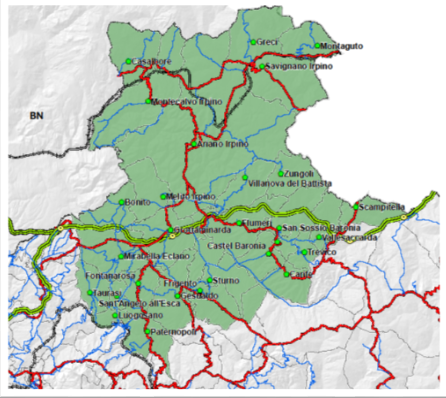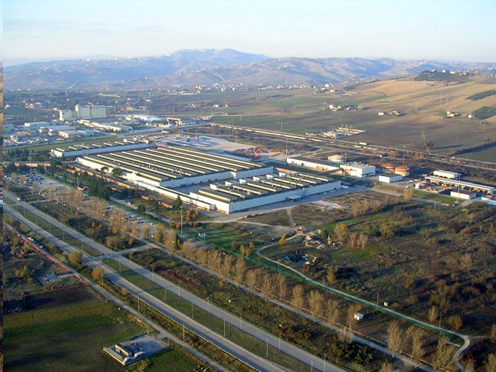Signed the Memorandum of Understanding for the definition of a Masterplan of the Ufita Valley.
The Regional Council with Regional Executive Decision No 148 of 21 March 2023 identified the target area for drawing up a Masterplan for the Ufita Valley area in the municipalities: Ariano Irpino, Bonito, Flumeri, Frigento, Gesualdo, Grottaminarda, Melito Irpino, Montaguto, Savignano Irpino, Sturno, Villanova del Battista;
A buffer area is integrated into the target area according to specific development guidelines (ecological and landscape, heritage, production) which includes the municipalities of: Carife, Casalbore, Castel Baronia, Fontanarosa, Greci, Luogosano, Mirabella Eclano, Montecalvo Irpino, Paternopoli, San Nicola Baronia, San Sossio Baronia, Sant’Angelo all’Esca, Scampitella, Taurasi, Trevico, Vallesaccarda, Zungoli, an area of 773.81 sq. km. with a population of around 79 000 residents by 2020.
The target area is framed by the Regional Territorial Plan (PTR) with the Territorial Development System B4 Valle Ufita (Rural-Cultural Dominant System).
The municipalities in the target area fall within two aggregations of the ‘City Systems’ provided for in the Territorial Coordination Plan of the Province of Avellino (approved by Provincial Council Decision No 42 of 25 February 2014) to promote the strengthening of provincial urban structures and coordinated planning at the level of several neighbouring municipalities.

Against this background, the Memorandum of Understanding, annexed to Regional Executive Decision No 148/2023, signed between the Campania Region and the municipalities concerned, identifies the following strategic priorities for the development of the Ufita Valley area:
1. Rehabilitation and completion of the road transport network in order to implement connections with the new Hirpinia station
The territory of the Ufita Valley is located on the axis of Intermodal Corridor VIII (Bari-Sofia-Varna), which connects Europe from Lisbon to Istanbul via Madrid, Barcelona, Naples, Bari and Athens.
The construction of the Hirpinia station of the Naples-Bari high-speed/high-capacity railway (and related services) is strategic, providing the area with an opportunity to define an appropriate and dynamic model of development and well-being in the medium to long term, re-reading and updating the position of the area and its peculiarities in regional and European ‘long-distance networks’. Station Hirpinia is the gateway to an integrated local system of tourism and high-quality, innovative and sustainable production, which can also be adequately supported by the reactivation of the Avellino-Rocchetta Sant’Antonio railway line for tourism purposes.
The completion of the road transport network starts from the need to "rammagliare", around a few but important nodes, an area that can find a relocation in the "flows" and in the network generated by strategic infrastructures will increase the accessibility of the territory generating important repercussions in terms of economic recovery. Very important are the connection Tre Torri-La Manna-Ariano-Camporeale, the functional connection with the industrial cores of Flumeri, Frigento, Sturno and Castel Baronia, the connection with State Road 90, with the Melito-Ariano Irpino junction, and the completion of the Lioni-Grottaminarda.
Pending the definition of the investment plan for the construction of a large intermodal logistics platform in Valle Ufita and the road infrastructure connections necessary to connect it to neighboring municipalities. Already financed for a first tranche of EUR 26 million by the NRRP under Mission 5, C3 Intervention 4, is the construction of a ‘freight terminal with an adjoining sorting, loading and unloading area for containers and swap bodies and an intermodal rail/rubber hub for semi-trailer boarding’.
2. Redevelopment and innovation of the production system and the manufacturing system, including through the upgrading of the present SEZ area and the regeneration of underused or disused industrial areas and sites;
Valle Ufita (AV) is included in the ZES area of the Campania region with an area of 237.25 hectares. The perimeter concerns the ASI area (Valle Ufita), located almost entirely in the municipality of Flumeri and for a small part in the municipality of Frigento.
The surface is occupied for about 70% from industrial plots of 141.84 hectares distributed as follows:
- 2.99% small industry
- 13,50% Mid-industry
- 62,78% large industry
Among the production sectors present, transport prevails, the presence of companies in the metalworking, chemical, recycling and material storage sectors is also significant.
The area is 7 km from the Grottaminarda junction of the A16 motorway, which provides connections to Naples and Bari. The Avellino – Salerno motorway junction is also used from the Avellino Est exit of the A16.
In the Ufita Valley, in addition to the ZES area, there are numerous PIP areas with disused industrial structures that can be reused.
The Masterplan area can develop, alongside the mechanical and agri-food sectors, the creation of a "technological cluster" where initiatives in the high-tech sector can take shape that raise the rate of innovation and that, like the Hirpinia Station in terms of high capacity for goods, represents the node of the potential "high innovation" of the area. To this end, the presence of existing Research Centres (INGV Grottaminarda and Biogem Ariano Irpino) should be strengthened by promoting synergy with the local production and education system.
3. Reinforcement of policies that contribute to reducing the phenomenon of demographic decline
The demographic trend in the euro area is particularly negative compared with a trend that has been declining for decades and the main indicators characterising the demographic structure show that the population is older than the regional figure.
In order to halt the depopulation taking place in the area, in addition to addressing the material and infrastructural factors mentioned above, it is also necessary to address the substantial welfare conditions of citizens, young people and others.
Ariano Irpino is the only centre with a good supply of public services and sports and recreational facilities. However, it is not easily accessible both for its location on a high hill (817 m above sea level) and for the quality of the road connections. This structural deficiency creates for small countries a condition of material and cultural isolation with many difficulties in accessing essential services.
With regard to welfare, it will be necessary to promote and support the creation of a social and health system widespread throughout the territory, in particular with the involvement of the third sector as regards services to people, with the use – also in this case – of the ‘empty’ structures available in the individual municipalities that can be made functional to a specialisation, diversification and expansion of the health and social health offer.
The objective must be to achieve the provision of a quality service for the patient-citizen, returning territoriality to care and avoiding health migration.
It is necessary to aim at reducing disparities in social and health conditions, aiming at a "widespread network" aimed at the needs of citizens. The trend to be increased must be to expand the use of integrated home care, organizing the emergency service in order to reduce the expectations of local rescue vehicles. Outpatient services for the performance of specific treatments (chemotherapeutic, radiotherapeutic, dialysis, etc.) should be disseminated, adapting and orienting them to the local population in the individual communities.
In this direction, the recent allocation of resources allocated with the NRRP to:
Investment 1.1: Houses of the Community and care of the person for about 4,7 million euros in the municipalities of Montecalvo Irpino, Fontanarosa and Castel Baronia with beneficiary ASL Avellino.
Investment 1.1.1: Modernization of the hospital technology and digital park (DEA Digitization) for about 4 million euros in the Municipality of Ariano Irpino with beneficiary ASL Avellino
Investment 1.1.1: Modernisation of the hospital technology and digital park (large equipment: ecotomographs, 128-layer CT scans, radiological systems) for about 850 thousand euros in the municipality of Ariano Irpino with beneficiary ASL Avellino.
Moreover, for families, the threat of school closures due to the decrease in enrolments (as a result of the decrease in school-age residents) has a significant impact on their quality of life, due to the lengthening of travel times to reach the nearest school that ends, in some cases, in the transfer decision and in the consequent further depopulation of minor municipalities.
It is therefore strategic to govern the process of reorganising the presence of schools in the territory in relation to the needs of the resident community, strengthening inter-municipal and inter-institutional dialogue for the efficiency of the school service offer.
Policies for the upgrading of road infrastructure and those supporting the construction of the Naples-Bari high-speed rail/high-speed rail line could have a positive impact on the demographic liveliness index of the municipalities crossed, also thanks to ‘densification’ measures around the station areas. In addition, the enhancement of digital infrastructures that allow the development of innovative production activities and enable new smart working possibilities that can facilitate housing choices that prioritise the high environmental quality of less densely urbanised areas.
4. Environmental regeneration and enhancement aimed at landscape redevelopment and reduction of hydrogeological risk
Although there are no areas recognised as ‘regional or national parks’, there is a widespread presence of sites of natural and environmental interest, including the ‘Boschi e Sorgenti della Baronia’ SPA area, the ‘Panorami di Frigento’ urban park and the Regio Tratturo nature attraction.
However, the territory is subject to environmental pressures such as a large wind farm on the border with Puglia and the two RSU landfills of Difesa Grande (closed) and Pustarza which is still active. In addition, there are many mountain areas subject to high hydrogeological risk.
Securing the area must be a central, non-episodic or emergency measure, not only because of the normal need to take care of the hydrogeological structure and hydraulic grids, but also because of the wide-ranging effects it may have in terms of protecting the environment and areas of natural value.
5. Reinforcement and upgrading of the agricultural and livestock supply chain system aimed at enhancing the value of products of territorial agricultural excellence
The area is characterised in particular by the production of excellent food and wine products, confirmed by the presence, above the regional figure, of holdings with PDO/PGI production (9.08% towards regional data 7,16%), and for the presence of female-run holdings.
Quality, value and niche products and offers run through the entire productive fabric of the area, from agriculture and agri-food (starting with the excellence of ancient grains/flour, oil (Ravece and PDO Irpinia Colline dell’Ufita) – and wine (the area falls partly within the scope of the ‘Taurasi Docg’). Other valuable products are the Potato of Trevico, white garlic of Ufita, and Caciocavallo Podolico.
On the contrary, a problem lies in the excessive fragmentation of the sector, which is evident from the prevalence of “individual” enterprises (99.6).%), and the presence of small holdings (average area of 5.13 hectares) in line with the regional figure.
“Quality production” in the broad sense of the territory can also find a renewed impetus in terms of the market in strengthening physical, digital and energy accessibility and in the general pursuit of innovative and sustainable policies.
The push for openness to the outside world and ‘marketing’ that can be offered by the railway (including the Avellino-Rocchetta tourist railway) and the digital network will have a positive impact on the shortening of the production chain, the development of supplementary activities (reception and marketing), the qualification of production and supply through the relationship with universities, the creation of an area ‘brand’ and the ambition to be a ‘brand’.
6. Urban regeneration aimed at urban regeneration of the identified area and promotion of actions for the enhancement and use of the cultural and natural heritage
The target area is characterised by a high number of landscape and cultural resources linked to the history of the area and its consolidation. Its role as a hinge, but also as a sentinel from above, between the Adriatic and the Tyrrhenian coast, has made these places a settlement site since ancient times. Therefore the territory is rich in testimonies of great artistic and historical value, first of all the settlement system linked to the castles in medieval times.
Among the historical and cultural potential is the passage of the Regio Tratturo in the territory of Montecalvo, Casalbore, Ariano Irpino, Villanova del Battista and Zungoli and the Via Francigena, the way of pilgrims who traveled this strip of Irpinia to the port of Brindisi from which to embark towards the Holy Land in the Middle Ages.
The identification and description of these resources helps to outline an intervention strategy that identifies the enhancement of the existing one of the matrices of the overall development of the territory.
7. Strengthening and innovation of the administrative system for faster and more effective implementation of interventions
The experiments already carried out in other regional territorial contexts have shown how one of the most important assets for the success of the strategies defined by the Masterplan is represented by the ability to collaborate and work together that the territories are able to express. The Masterplan project builds on the experiences of supra-municipal governance already active in the area. In this sense, the presence of the Union of Municipalities of Ufita and the Association of Municipalities of Ufita, Calore, Miscano and Cervaro, established pursuant to Article 30 of Legislative Decree No 267/2000, may represent the next step in the implementation of the actions envisaged by the Programme.




